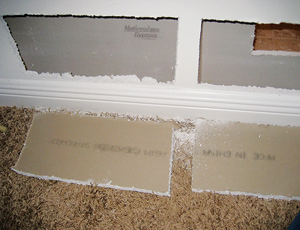Amid a growing chorus of complaints, two U.S. Senators have introduced legislation to recall Chinese-made drywall and to ban further imports until federal safety standards are developed. Meanwhile, Florida’s governor has asked the U.S. Environmental Protection Agency to help the state develop and implement chemical-testing strategies.
Senators Bill Nelson (D-Fla.) and Mary L. Landrieu (D-La.) introduced legislation on Mar 30 pressing the Consumer Product Safety Commission to recall Chinese-made drywall and work with federal testing labs to determine the exact level of hazard posed by off-gassing from the drywall. The bill also calls for an interim ban on imports. “This defective Chinese drywall represents an attack on our homeowners, a defrauding of our homebuilders and another obstacle on our road to recovery,” says Landrieu. “The federal government now has a responsibility to assess the full scope of the problem and immediately prohibit further importation.”
Since 2006 over 550 million lb of drywall has been imported to the U.S., with 60% going to Florida, say the senators. Nelson says about 60 million lb arrived in Louisiana and 27 million lb in Mississippi during that same period. Landrieu and Nelson estimate between 60,000 and 100,000 homes may contain “potentially defective drywall.” Other states affected by the imported material include Virginia, Alabama and California.
Earlier this year, several lawsuits were filed in Florida alleging products from Knauf Gips KG, Knauf Plasterboard Tianjin Co. Ltd. (KPT) and Taishan Gypsum Co. Ltd. produced sulfur-smelling gasses and corrosion of copper wiring and piping. KPT says its half-inch drywall was imported between January and October 2006 and represents less than 20% of the Chinese plasterboard imported between 2005 and 2007.
At least 289 complaints have been recorded by the Florida Dept. of Health (FDOH). On April 3, Florida Gov. Charlie Crist (R) wrote the Environmental Protection Agency and Centers for Disease Control and Prevention requesting assistance with chemical testing. He noted that preliminary FDOH tests confirmed “the presence of strontium sulfide and elemental sulfur in drywall from China.”
Further, the testing confirmed that the drywall generated hydrogen sulfide, carbonyl sulfide and carbon disulfide when exposed to high humidity or heat. “All of these compounds are capable of causing the type of corrosion identified in the complaint homes and at sufficient concentrations could pose a health hazard,” says Crist. He wants a testing program to see if a health advisory is warranted.
In late January, FDOH commissioned an analysis of four drywall samples: one American-made, one unmarked, one marked Knauf and one marked Made in China. The report from Unified Engineering Inc., Aurora, Ill., noted there is a distinct difference in drywall manufactured in the U.S. and China. “The Chinese samples contained traces of strontium sulfide inclusions and more organic material than the [U.S.] sample,” it said. “However, it is not yet known if either contributed to the odor. The Chinese samples gave off a sulfur odor when exposed to extreme heat and moisture.”
Different types of drywall may have been used in the same house. “We are in the process of identifying a lab for further testing of indoor-air samples,” says Susan S. Smith, FDOH press secretary.












Post a comment to this article
Report Abusive Comment